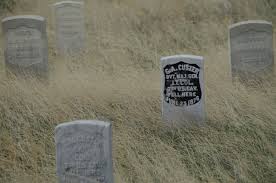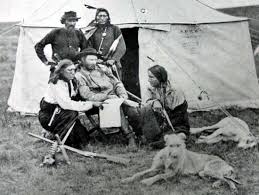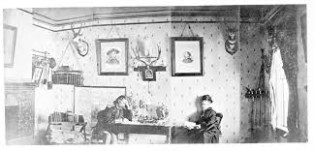1873 – Calamity Jane claims to have given birth to Wild Bill Hickok’s daughter, Jeney.
Suddenly Alone
Enter now to win a copy of the book
None Wounded, None Missing, All Dead: The Story of Elizabeth Bacon Custer.
“Few men had more enemies than Custer, and no man deserved them less.”
Author Frederick Whittaker – 1877
Persistent raindrops tapped against the windows of Elizabeth Custer’s Park Avenue apartment in New York. The prim, 74 year-old women, dressed head to toe in black, Victorian clothing, stared out at the dreary, foggy weather. She wore a pensive expression. Her graying hair was pulled back neatly into a tight bun, a few loose tendrils had escaped and gently framed her small face. Her throat was modestly covered with lace.
The room around Elizabeth was grand in size and filled with items she had collected from her days on the western plains. Framed drawings of the Kansas prairie, a trunk with George’s initials across the top, photographs of friends and family at various outposts, and an assortment of books on subjects ranging from travel beyond the Mississippi to the types of wild flowers that lined the Oregon trail were among her treasures. The sparse furnishings in the apartment were covered with newspapers and journals. A small desk was littered with hundreds of letters.
Elizabeth glanced at the clock on a nearby table then clicked on a radio housed in a gigantic cabinet beside her. As she tuned the dial through static and tones, a bright, maroon light sifted into the hollow of the dark room. At the same time the fog outside the window lifted a bit and the vague, misty outlines of palatial apartment buildings, museums, and churches came into view.
Elizabeth found the radio station she was looking for and leaned back in a plush chair as a voice described upcoming programming. She pulled a shawl around her shoulders and sat patiently waiting. After a few moments an announcer broke in with pertinent information about the broadcast. The program Elizabeth was tuned in to was Frontier Fighters and the episode was entitled Custer’s Last Stand. The airdate was June 26, 1926, 50 years after the Battle at Little Bighorn.
As the reenactment unfolded, Elizabeth’s eyes settled on a photograph of George hanging on the wall above the radio and she remembered that awful moment. The devastated look on the faces of the 20 wives who lost their husbands the same day she lost hers would never be forgotten. “From that time the life went out of the hearts of the women who wept,” Elizabeth wrote in her memoirs, “and God asked them to walk on alone in the shadows.”
To learn more about Elizabeth Bacon Custer and her marriage to George Armstrong Custer read
None Wounded, None Missing, All Dead: The Story of Elizabeth Bacon Custer.
This Day…
Losing George
Enter now to win a copy of the book
None Wounded, None Missing, All Dead: The Story of Elizabeth Bacon Custer.
“Indescribable yearning for the absent, and untold terror for their safety, engrossed each heart.”
Elizabeth Custer on waiting to hear news about the fate of George and the members of his command – 1885
It was almost two in the morning. Elizabeth couldn’t sleep. It was the heat that kept her awake, the sweltering, intense heat that had overtaken Fort Lincoln earlier that day and now made even sleeping an uncomfortable prospect. Even if the conditions for slumber were more congenial, sleep would have eluded Elizabeth. The rumor that had swept through the army post around lunchtime disturbed her greatly and until this rumor was confirmed she doubted that she’d ever be able to get a moment’s rest.
Elizabeth walked her anxious frame over to the window and gazed out at the night sky. It had been more than two weeks since she had said goodbye to her husband. She left him and his troops a few miles outside of Fort Lincoln. His orders were to intercept the Sioux and Cheyenne Indians in the territory, force them back to the reservation, and bring about stability in the hills of Montana.
Just before riding out she turned around for one last glance at General George Custer’s column departing in the opposite direction. It was a splendid picture. The flags and pennons were flying, the men were waving and even the horses seemed to be arching themselves to show how fine and fit they were. George rode to the top of the promontory and turned around, stood up in his stirrups and waved his hat. Then they all started forward again and in a few seconds they had disappeared, horses, flags, men, and ammunition – all on their way to the Little Bighorn River. That was the last Elizabeth saw of her husband alive.
Over and over again she played out the events of the hot day that made her restless. Elizabeth and several other wives had been sitting inside her quarters singing hymns. They desperately hoped the lyrics would give comfort to their longing hearts. All at once they noticed a group of soldiers congregating and talking excitedly. One of the Indian scouts, Horn Toad, ran to them and announced, “Custer killed. Whole command killed.” The woman stared back at Horn Toad in stunned silence. Catherine Benteen asked the Indian how he knew that Custer was killed? He replied: “Speckled Cock, Indian Scout, just come. Rode pony many miles. Pony tired. Indian tired. Say Custer shoot himself at end. Say all dead.”
To learn more about Elizabeth Bacon Custer and her marriage to
George Armstrong Custer read
None Wounded, None Missing, All Dead: The Story of Elizabeth Bacon Custer.
This Day…
Plains Living
Enter now to win a copy of the book
None Wounded, None Missing, All Dead: The Story of Elizabeth Bacon Custer
“My husband used to tell me that he believed he was the happiest man on earth, and I cannot help but thinking he was.”
Elizabeth Custer – 1882
A group of some 40 officers and their wives congregated in the parlor of George and Elizabeth Custer’s home at Fort Abraham Lincoln in North Dakota. A fiddler entertained several men and women at one end of the tastefully decorated room. More guests paraded past a table filled with a variety of food and drinks at the other. Elizabeth manned the door, kindly welcoming latecomers to the party in progress. She touched her finger to her lips indicating that the attendees should enter quietly.
The music stopped. A hush fell over the guests. Elizabeth’s brother-in-law, Tom, sister-in-law, Maggie, and family friend, Agnes, marched into the setting and crossed to the musicians. All three wore costumes. Maggie was dressed as a Sioux Indian Maiden. Agnes and Tom were dressed as Quakers. George and the others in attendance stifled a chuckle as the trio struck a dignified pose for the captive audience. They were acting out a scene from a current event in the region. Known as a tablie ux, the object of the entertaining charade was to guess the event and whom the players represented.
Partygoers enthusiastically shouted out their best guesses. Others issued comical remarks that made everyone erupt in laughter. When the right guess was announced the actors broke character and took a bow. The happy audience applauded their efforts and the music started up again.
To learn more about Elizabeth Bacon Custer and her marriage to George Armstrong Custer read
None Wounded, None Missing, All Dead: The Story of Elizabeth Bacon Custer.
This Day…
Trouble Apart
Giveaway! Enter now to win a copy of the book
None Wounded, None Missing, All Dead: The Story of Elizabeth Bacon Custer.
“I would be willing, yes glad, to see a battle everyday during my life.”
George Custer – October 1862
Spirited music and laughter burst through the doors of Chicago’s Opera House. The velveteen drapes subdued the whir of roulette wheels that lined the theatre lobby and muffled the voices of the Faro dealers. Patrons poured into the establishment seeking entertainment and shelter from the freezing cold. Chicago was a city of handsome dwellings whose elegance and refinements were reflected in the brilliant social life. A throb beat through its every artery. One of the many acts that could hold the attention of the bustling area was Lydia Thompson’s British Blondes. The troupe of celebrated actresses with overwhelming proportions who specialized in dancing and pantomime, performed for packed houses nightly. Among some of the most famous audience members were Grand Duke Alexis Romonoff, Wild Bill Hickock, and George Custer.
Over the Thanksgiving holiday in 1869, George had visited the show a couple of times, partaking not only in the burlesque styling of the irresistible sirens, but the popular games of chance that greeted people when they entered the building. George had been in Michigan taking care of family business when he decided to travel to Illinois to visit Phil Sheridan, his former army commander and respected mentor who was ill. News that he was in the Windy City spread quickly and George was inundated with invitations to attend dinners and theatrical openings. His reputation as soldier and military leader, along with the numerous published articles he had written about his combat experience, preceded him. Everyone wanted to be in George’s company and he delighted in the attention. Local newspapers reported on his outings, giving special concentration to the fact that Elizabeth was not at his side. “George Custer,” the article began, “has been seen about without his wife, chasing blondes instead of Indian maidens.” He made light of the report in a letter he wrote to Elizabeth and let her know that in addition to the Blonde Beauties Show he also took in a play featuring the best known comedian of he day, Joseph Jefferson. “I never had so nice a time in all my life – expect when I am with you,” George assured his wife.
Elizabeth read over her husband’s letters from their quarters at Fort Leavenworth, Kansas. She usually accompanied George in his travels, but for this trip she decided to remain behind. Her cousin, Anne Bingham, was coming to visit and she didn’t want to miss spending time with her. After receiving George’s letter Elizabeth wished she had gone with him. Along with the list of entertaining activities, his correspondences contained some worrisome information about playing cards with friends. George was a gambler who found it difficult to resist a game.
To learn more about Elizabeth Bacon Custer and her marriage to
George Armstrong Custer read
None Wounded, None Missing, All Dead: The Story of Elizabeth Bacon Custer.
This Day…
Custer’s Maiden
Take a chance. Enter to win a copy of the book
None Wounded, None Missing, All Dead: The Story of Elizabeth Bacon Custer.
“…Girls needn’t try to get her dear Bo away from her, because he loves only her, and her always.”
George Custer to Elizabeth Custer – 1871
The day was gray, and a raw, cold wind swirled outside the windows of the late Judge Albert Bacon’s home in Monroe, Michigan. It was early fall 1868. The Judge’s daughter, Elizabeth, and son-in-law, George, sat inside the parlor of the stately home. Each was quietly involved in their individual tasks. George was hunched over a writing table working on a book about his days at West Point. Elizabeth set aside some sewing she was doing and drifted over to a piano in the corner of the room. Her husband glanced up from his writing long enough to see that Elizabeth wasn’t going far. After weeks of being apart he wanted her near him at all times.
The genteel army wife made herself comfortable at the polished keyboard then reached for a stack of music bound in a faded leather pouch. She untied the ribbon holding the music together and sifted through the pages. Inside one of the pieces of sheet music was a daguerreotype of George. It had been taken in April 1865 and he was dressed in his major general uniform; the two stars on his collar clearly displayed. Some of the music had left its imprint on the picture, the notes like a melody over his face.
Elizabeth sat her husband’s picture on the stand next to the song she selected and began to play. The ebullient sound filled the air. Although he was tapping his foot in time with the beat, George’s attention was trained on the assignment before him.
For a moment Elizabeth wondered if he might only be pretending to be engrossed in writing. She worried that he longed to be doing something else. Nearly a year had passed since a nine member military jury found George guilty of “leaving his post without permission, excessive cruelty, and illegal conduct in putting down mutiny in the 7th Cavalry by shooting deserters.” The punishment he received as a result of the court-martial was a year suspension from rank, duty, and pay. George’s yearly pay was $95 a month.
George and Elizabeth were affected by the verdict. Courts-martial were commonplace. More than half the army servicemen were tried and court-martial in 1867 alone. Far from feeling disgraced by the ordeal, the Custers planned to spend the time away from the job and the frontier enjoying one another’s company, entertaining family, and traveling abroad.
After a short respite from frontline service Elizabeth began to doubt how long George would remain content away from active duty. She knew how much her husband loved the soldier’s life. He had once admitted, “I would be willing, yes glad, to see a battle every day during my life.”
To learn more about Elizabeth Bacon Custer and her marriage to George Armstrong Custer read
None Wounded, None Missing, All Dead: The Story of Elizabeth Bacon Custer.






